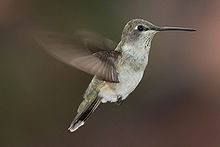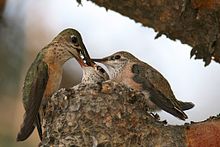I am still enjoying the Spring Migration thru my corner of Texas. Tonight we celebrate the hummingbird. I built my Bird Sanctuary specifically for the tiny birds as I promised Mom before she left. Mom had a passion for these birds long before I 'had time' for anything like that. My work (as a Chef) was all that mattered when I was 'Important' back then. Time has a way of changing things not necessarily in the direction you might have thought.
I no longer cook and I now have time to feed the birds, take my photos, and learn the computer. My life has been enriched beyond measure because of changes that occurred. Because of my Mom's Love for the Hummingbirds and Me, I can now pass all that love and goodness on to all of You who come by here! Share the Love!
Happy Mothers Day to All MOMS!!!!!!!!!!
At Kates Cabin Today:
From my courtyard 3 days ago:
https://en.wikipedia.org/wiki/Hummingbird
Hummingbird
From Wikipedia, the free encyclopedia
Hummingbirds are birds that comprise the family Trochilidae. They are among the smallest of birds, most species measuring in the 7.5–13 cm (3–5 in) range. Indeed, the smallest extant bird species is a hummingbird, the 5-cm Bee Hummingbird. They hover in mid-air by rapidly flapping their wings 12–80 times per second (depending on the species). They are known as hummingbirds because of the humming sound created by their beating wings, which sometimes sounds like bees or other insects. A group of hummingbirds is called a "choir." To conserve energy while they sleep or when food is scarce, they have the ability to go into a hibernation-like state (torpor) where their metabolic rate is slowed to 1/15th of its normal rate.[1] When the nights get colder, their body temperature can drop significantly and thus slow down their heart and breathing rate, thus burning much less energy overnight. As the day heats back up, the hummingbird's body temperature will come back up and they resume their normal activity. [2] They can fly at speeds exceeding 15 m/s (54 km/h; 34 mph);[3] they are also the only group of birds with the ability to fly backwards.[4]Individuals from some species of hummingbirds weigh less than a penny.
| Hummingbird | |
|---|---|
 | |
| Female Black-chinned Hummingbird | |
| Scientific classification | |
| Kingdom: | Animalia |
| Phylum: | Chordata |
| Class: | Aves |
| Subclass: | Neornithes |
| Infraclass: | Neognathae |
| (unranked): | Cypselomorphae |
| Order: | Apodiformes |
| Family: | Trochilidae Vigors, 1825 |
| Subfamilies | |
|
For a taxonomic list of genera, see:
For an alphabetic species list, see:
| |
Migration [edit]
Most hummingbirds of the U.S. and Canada migrate south in fall to spend the winter in northern Mexico or Central America. A few southern South American species also move to the tropics in the southern winter. A few species are year-round residents in the warmer coastal and southern desert regions on the USA. Among these is Rufous Hummingbird, a winter resident in Florida, parts of the Gulf coast, and up to the lowlands of coastal South Carolina/Gerogia, and Anna's Hummingbird, a common resident from California inland to southern Arizona and north to southwestern coastal British Columbia.
The Rufous Hummingbird is one of several species that breed in North America and are wintering in increasing numbers in the warm subtropical southeastern United States, rather than in tropical Mexico. The Rufous Hummingbird nests farther north than any other species and must tolerate occasional temperatures below freezing on its breeding grounds. This cold hardiness enables it to survive brief temperatures below freezing, provided that adequate shelter and feeders are available.

| Description |
English: Hummingbird in Copiapo, Chile
|
| Date | |
| Source | Own work |
| Author | Rishiraj |
Reproduction [edit]
As far as is known, male hummingbirds do not take part in nesting. Most species build a cup-shaped nest on the branch of a tree or shrub, though a few tropical species normally attach their nests to leaves. The nest varies in size relative to species, from smaller than half a walnut shell to several centimeters in diameter. In many hummingbird species, spider silk is used to bind the nest material together and secure the structure to its support. The unique properties of silk allow the nest to expand with the growing young. Two white eggs are laid, which, despite being the smallest of all bird eggs, are in fact large relative to the hummingbird's adult size. Incubationlasts 14 to 23 days, depending on species, ambient temperature, and female attentiveness to the nest. The mother feeds her nestlings on small arthropods and nectar by inserting her bill into the open mouth of a nestling and regurgitating the food into its crop.
There are between 325 and 340 species of hummingbird, depending on taxonomic viewpoint, divided into two subfamilies, the hermits (subfamily Phaethornithinae, 34 species in six genera), and the typical hummingbirds(subfamily Trochilinae, all the others). However, recent phylogenetic analyses suggest that this division is slightly inaccurate, and that there are nine major clades of hummingbirds: the topazes and jacobins, the hermits, themangoes, the coquettes, the brilliants, the Giant Hummingbird (Patagona gigas), the mountain-gems, the bees, and the emeralds.[29] The topazes and jacobins combined have the oldest split with the rest of the hummingbirds. The hummingbird family has the second greatest number of species of any bird family on Earth (after the tyrant flycatchers).
Fossil hummingbirds are known from the Pleistocene of Brazil and the Bahamas; however, neither has yet been scientifically described, and there are fossils and subfossils of a few extant species known. Until recently, older fossils had not been securely identifiable as those of hummingbirds.
In 2004, Dr. Gerald Mayr of the Senckenberg Museum in Frankfurt am Main identified two 30-million-year-old hummingbird fossils and published his results in the journal Science.[30] The fossils of this primitive hummingbird species, named Eurotrochilus inexpectatus ("unexpected European hummingbird"), had been sitting in a museum drawer in Stuttgart; they had been unearthed in a clay pit at Wiesloch–Frauenweiler, south of Heidelberg, Germany and, because it was assumed that hummingbirds never occurred outside the Americas, were not recognized to be hummingbirds until Mayr took a closer look at them.
FROM YOU TUBE SITE:
http://www.youtube.com/watch?v=VZLrPN3t2_Y
Published on Aug 6, 2012
Watch 2 different Hummingbird nests @ our house with young, grow up and leave the nest.
About 20 days after hatching they are flying. Pictures are close-up and personal, they should make you smile. First nest is on a metal hummingbird pull chain on our patio fan, second on the China Doll bush next to our bedroom door. A video at the end of them feeding, an all day event. About 10 lbs of sugar a week for the feeders. I made this for my Wife, who loves these little things. She thought it would be great to share with everybody & hope you enjoy it as much as we do.
About 20 days after hatching they are flying. Pictures are close-up and personal, they should make you smile. First nest is on a metal hummingbird pull chain on our patio fan, second on the China Doll bush next to our bedroom door. A video at the end of them feeding, an all day event. About 10 lbs of sugar a week for the feeders. I made this for my Wife, who loves these little things. She thought it would be great to share with everybody & hope you enjoy it as much as we do.
Category
License
Standard YouTube License
The Following Photos I took last year and edited in the Picnik Program, which no longer exists.









http://www.youtube.com/watch?v=AUg_zEtJJy8
Of course, one more (or so) great performance:
http://www.youtube.com/watch?v=hjnc1kHMDDo
Uploaded on Jan 9, 2010
See the full episode at http://video.pbs.org/video/1380512531
We all have preconceived ideas about what hummingbirds' lives are like, but so much of their world is imperceptible to the human eye. Filmmaker Ann Prum describes the breakthrough science and latest technologies that allowed her and the crew to reveal incredible new insights about these aerial athletes.
"Hummingbirds: Magic in the Air" aired on PBS Wednesday, September 28, 2011 and was part of the 28th season of the Peabody and Emmy award-winning series produced by Thirteen in association with WNET.ORG for PBS. Major support provided by Canon U.S.A. Inc. http://www.pbs.org/wnet/nature/episod...
We all have preconceived ideas about what hummingbirds' lives are like, but so much of their world is imperceptible to the human eye. Filmmaker Ann Prum describes the breakthrough science and latest technologies that allowed her and the crew to reveal incredible new insights about these aerial athletes.
"Hummingbirds: Magic in the Air" aired on PBS Wednesday, September 28, 2011 and was part of the 28th season of the Peabody and Emmy award-winning series produced by Thirteen in association with WNET.ORG for PBS. Major support provided by Canon U.S.A. Inc. http://www.pbs.org/wnet/nature/episod...
Category
License
Standard YouTube License
















No comments:
Post a Comment
Hi Everybody! Please say hello and follow so I know you are here! Due to the inconsideration of people trying to put commercials on my blog comment area, I have restricted use of anonymous posts. Sorry that some hurt all.
My public email is katescabin@gmail.com No spammers or trolls